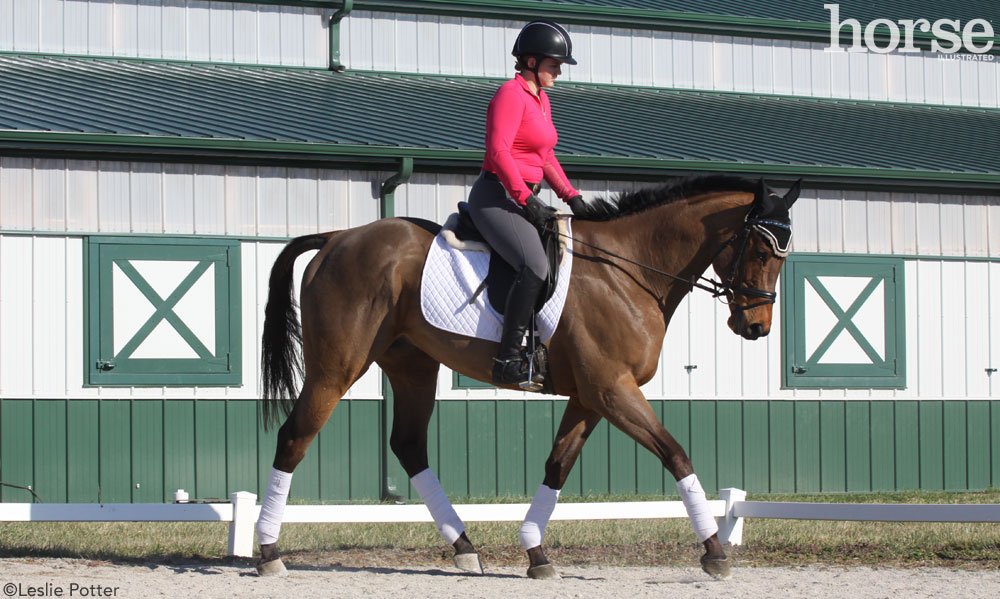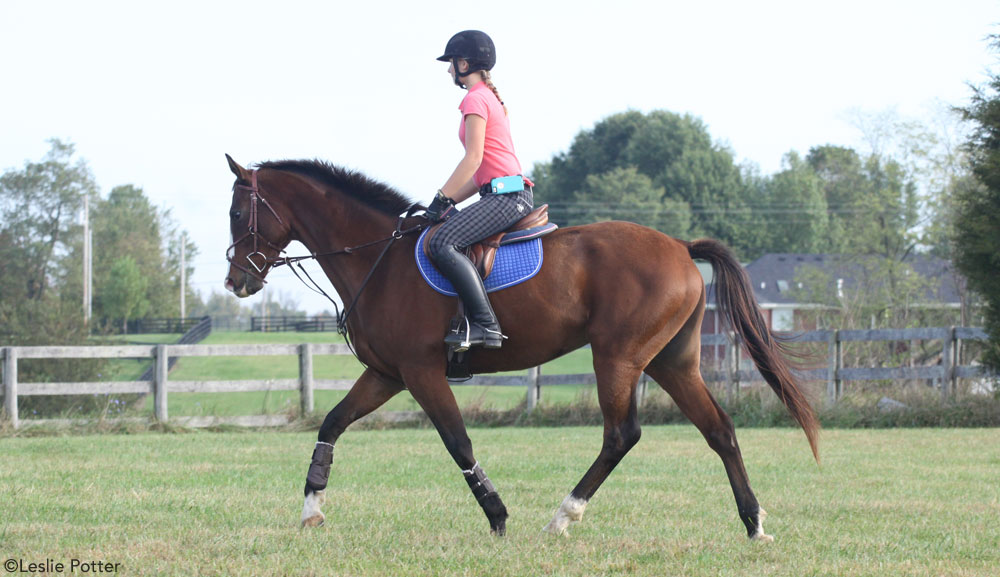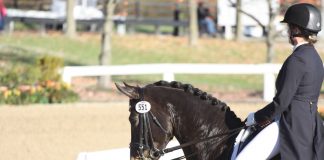Is a sharp and peppy response to your leg missing from your horse’s vocabulary? While a laid-back horse might otherwise be speaking your language, a forward-thinking tune-up could be in order.

Use transitions between gaits, such as walk-trot-walk-trot, to sharpen your horse’s response to your leg.
Position Check
If your horse is not reactive enough to your driving aids, you should first assess your own position, recommends Kim Herslow, a Grand Prix dressage rider and United States Dressage Federation (USDF) gold medalist.
“Make sure you are not tipping in front of your seat bones, weighting the horse’s shoulders with your upper body,” says Herslow, whose most recent accomplishment includes a team gold win at the 2015 Pan Am Games in Toronto. “The seat weight is an important part of your balance that [communicates] to the horse to move forward. You have to unblock that balance by sitting up so the alignment of your position is clear. With an engaged back and clear use of leg, ask your horse to go forward. If he’s still not willing, you might need to encourage with more pressure, like a quick kick from the lower leg.”
Be sure that your leg aids are concise and clear. If your leg persistently nags or squeezes, your horse might tune you out. “Sometimes horses that are less sensitive need to have your leg off more than on,” says Herslow. “They get desensitized to constant leg pressure, like kicking and squeezing. Clamping, in which you use too much of your upper leg, actually slows the horse down.”
When subtle cues don’t elicit the desired response, come in with a sharp aid. A quick, clear, “Hey, you need to listen!” aid trains your horse to be alive to your leg. Once he reacts positively, you can return to subtle aids again. You might also need to employ a bit of spur or whip to encourage horses that tend to be lazy or stubborn off the normal driving aids.
Forward Thinking
Once you know your position and aids are sending the right message, you can start to rev your horse up with some simple transitions, engaging him by asking him to go forward and come back.
Herslow suggests starting out with walk-halt-walk-halt transitions, making sure you get a prompt response. “The horse should react off the walk aid,” she says. “If it takes a couple of seconds, you’ll need leg and a little spur to create more energy.”
Once the horse is quick to these aids, you can move on to walk-trot and trot-canter transitions to keep sharpening the horse’s reaction. “It’s important to keep asking the horse questions so he doesn’t get dull from doing the same movement or exercise for too long,” says Herslow. These transitions help make the horse prompt to your forward aids so he’s more sensitive and paying attention instead of tuning you out.
Be sure to praise your horse often for his efforts. “Always talk to the horse and reward him with your voice when you are schooling; pat him and use a positive voice to reward a correct response,” says Herslow. “Encouragement is often more helpful than having to get after the horse with stronger aids.”
Keep an eye on your own position while schooling these exercises. “It’s important in the transitions that you are aware of the stability of your upper body position,” says Herslow. “Stay aligned over your seat and leg with arms that are independent of your balance. When your horse goes to move forward, you don’t want to accidentally tell him to stop.”
Listen to the Leg-Yield
Leg-yield is another great exercise to get your horse moving off your leg. “First, make sure you have an active, forward response off your leg,” says Herslow. “Once your horse is willingly moving with a forward-thinking attitude, leg-yielding can make him sharper and produce a better forward connection to the reins.”
Herslow recommends starting with a leg-yielding exercise from the quarterline to the rail. Start by tracking left and turn down the quarterline of the arena. Once you’re straight on the line, engage through your core, back and seat, and use soft half-halts on your reins as you position your inside (left) leg behind the girth and increase left seat pressure to yield the horse over to the track.
Your inside leg should squeeze in the rhythm you want from the horse. It’s important you connect with the outside rein to keep the horse’s shoulders straight and facing forward; the shoulders and haunches need to stay in alignment. Keep your eyes up looking towards a point that you are riding to; looking down can make the horse feel stuck.
Through this exercise, your horse should move forward and sideways evenly. If he isn’t reacting off your leg, you can tap the whip in coordination with your leg. Ride this exercise in both directions, keeping in mind one side is usually harder than the other, so you may have to adjust the position of your leg farther back on the harder side, according to Herslow.
If you have them, mirrors are very helpful to check for the correct alignment of your horse’s shoulders and haunches. As you get more comfortable leg-yielding, you can increase the distance you are yielding by turning down the centerline or even the second quarterline.

Try changing things up to keep your horse interested. Schooling outside the arena is a great way to keep your routine fresh.
Hidden Dangers
Sometimes when horses with behavioral issues are pressed, they may react negatively, such as with a buck or rear. Herslow recommends making sure you understand your horse and how he might answer you when questioned; seek out qualified training help if you feel you need it. If a normally forward and responsive horse is suddenly reluctant to move out, schedule your vet to assess the situation—there may be an undetected physical problem.
Mix it Up
Quiet types often respond well to variety. “I recommend changing up the scenery with these horses,” says Herslow. This is includes schooling outdoors, hacking out, and cross-training with other exercises, such as cavalletti work. Find out what your horse enjoys and change up the routine to keep a fresh outlook.
Before you know it, “forward” will be a favorite word in your horse’s vocabulary!
Natalie DeFee Mendik is an award-winning journalist specializing in equine media. Her personal horse passions include dressage and vaulting. Visit her online at www.mendikmedia.com.
This article originally appeared in the February 2016 issue of Horse Illustrated magazine. Click here to subscribe!





